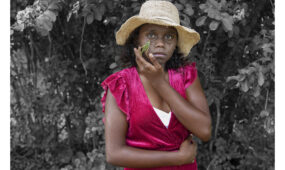What are Brandis's arts priorities?
InReview

Australian governments at all three levels have always had complex relationships with the arts and how they relate to Australian culture.
In 1819, for example, Governor Macquarie appointed the colony of New South Wales’ first “poet laureate”, Michael Massey Robinson.
According to the Australian Dictionary of Biography, Robinson was the recipient of the colony’s first arts grant, which consisted of “two cows from the government herd”. Robinson’s excitement was short-lived as a change of government and the appointment of a new governor, Sir Thomas Brisbane, saw the support quickly end.
Robinson responded by presenting “several ballads lamenting the departure of Macquarie and referring scornfully to his successor”.
Almost 200 years later, little has changed – as journalist and arts policy scholar Ben Eltham noted in his 2013 PhD, this is a scene all too familiar to contemporary arts practitioners; a change of government leads to a change of priorities, and what seems to be a flourishing opportunity suddenly disappears.
In other words, the government of the day sets the priorities for the arts – and that is always a reflection of the ideological framework. It’s not just a matter of what the government of the day prioritises through funding and general support – we also need to examine what is ignored or not discussed. The direction of funding essentially determines what stories get told.
Which brings us to Senator George Brandis who, when not attempting to explain big data as the Attorney-General, is also the Minister for the Arts. Brandis has his hands full as Attorney-General but it is nonetheless disappointing that his arts portfolio has had a much lower profile.
Last week, Brandis spoke to Michael Cathcart on ABC’s Radio National Books and Arts program about arts policy. The interview was quickly swamped by news of the death of Malcolm Fraser – a shame, as it was a rare opportunity for us to hear about the current Government’s priorities for the arts.
Though there is much to it, there are three important points we can draw from Brandis’s interview.
The first is that the Minister will continue the long tradition of taking a relatively conservative approach to Australian culture and arts funding. As Eltham and others have repeatedly observed, the vast majority of arts funding is directed to a handful of essentially conventional organisations such as Opera Australia.
At no time in his Books and Arts interview did Brandis indicate that funding needs to be directed to smaller, more nimble organisations that are usually more innovative and more likely to tell local stories. The opposite occurred as Brandis singled out the 28 major performing arts organisations for special mention.
In fact, Brandis rallied against any sort of parochialism in the arts – the second point worth noting. Brandis stated on Books and Arts that:
I am the enemy of anything parochial. Let me give you the best example I can think of. Last week I went to see John Bell’s production As You Like It.
Now, as a personal subscriber to Bell Shakespeare, it is good to know that in some ways my tastes overlap with those of the Attorney-General. However, to see an interpretation of the work of William Shakespeare – no matter how innovative – as Australian content, is questionable.
That’s not to say there is no room to subsidise organisations such as Bell Shakespeare or Opera Australia – but we must acknowledge that in a relative small pool of funding, other works do not get funded and important voices are ignored.
The third point is that Brandis acknowledged the need to continue to support the arts in Australia. He pointed out that:
In a country of 23 million people and in which the phrase you used before, the famous Geoff Blainey phrase, the tyranny of distance is such an important element of policy and the allocation of resources. It is necessary that the Government support arts companies if we are to have a healthy cultural sector.
But again, exactly what makes up a “healthy cultural sector” is never clearly outlined. Brandis is right when he both compares the arts funding to infrastructure, while at the same time saying that the arts are very different – they are the “soul of the nation”.
As a multicultural nation with an Aboriginal history stretching back millennia, Australian identity is as complex as it is diverse. It is both one that we can be proud of – and it can fill our hearts with shame. This is the case for past events (such as the brutal Frontier Wars waged by settlers) to the shameful treatment of refugees seeking asylum on this country.
The arts are at their best when they both entertain and make us look in the mirror to reflect on our society. But one thing this government seems never to be comfortable with is the latter – and the fact the Minister does not offer us anything new is disappointing.
There is much to learn and celebrate from small, nimble organisations that tell unique Australian stories. In its most recent production, Milk Crate Theatre focuses on powerful stories of homelessness, mental health and survival presented by an ensemble which have experienced such issues. The stories are an amalgam of actual life events.

Get InReview in your inbox – free each Saturday. Local arts and culture – covered.
Thanks for signing up to the InReview newsletter.
If governments continue to focus their funding on the top 28 arts organisations, such stories are rarely told and our complex society is never fully portrayed.
James Arvanitakis is Professor in Cultural and Social Analysis at University of Western Sydney. This article was first published on The Conversation.
Support local arts journalism
Your support will help us continue the important work of InReview in publishing free professional journalism that celebrates, interrogates and amplifies arts and culture in South Australia.
Donate Here





Comments
Show comments Hide comments